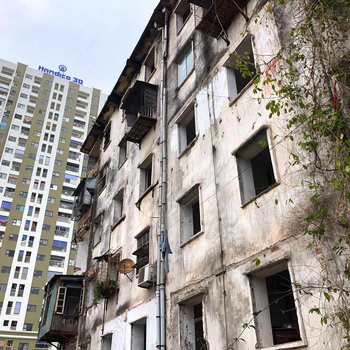Strictly speaking, Kiev Frescoes (Sergej Parajanov, USSR, 1966) is not a film, but a series of screen tests left behind after the project was shelved by Soviet censors. Born in Tbilisi, Georgia, by the mid-1960s Parajanov had become the face of a new aesthetic movement led by bohemian artists whose ideology was not easily reconciled with a Soviet Union still shaped by Stalinism. Poetic Cinema was largely built upon Parajanov’s Shadows of Forgotten Ancestors (Tini zabutykh predkiv, USSR, 1964), a film that is dedicated to the folklore of a Hutsul mountain village and tells the story through striking visuals. Strictly committed to socialist realism, the censors kept the cinematic poet in check, branding his takes for Kiev Frescoes as bourgeois, formalist and mysticistic – labels that may not have been factually wrong, but, in the Cold War’s conflict of systems, were highly ideologically charged. Parajanov’s cinematic works thus fell into a position in stark, programmatic contrast with the prevailing political and aesthetic order. In the early 1970s, the chair of the Ukrainian KGB reported to the central committee of the Communist party that Parajanov had defended a dissident and openly criticised the Soviet government, and the film-maker was finally arrested. From then on he was considered a “Ukrainian nationalist”.1 He had previously also been imprisoned in the 1940s for what was described as seducing men.2
1 Rosenbaum, Jonathan: Paradjanov’s Films on Soviet Folklore, In CINEASTE, Summer 2002, 42–44, 43. Rosenbaum lists a whole series of other accusations made against Parajanov, some extravagant (ranging “from dealing in foreign currency, speculating on art-works, and stealing icons to spreading venereal diseases”). All mainly appeared to be motivated by the fact that he was an eccentric troublemaker.
2 Tigran S. Simyan has written about Parajanov’s imprisonments. Simyan, Tigran S.: “Guilty of Being Free”: An Intellectual vs. Soviet Penal System (Prison Letters and Drawings of Sergei Parajanov), in Changing Societies & Personalities, 2022, Vol. 6, No1, 197–216, 206. [doi]
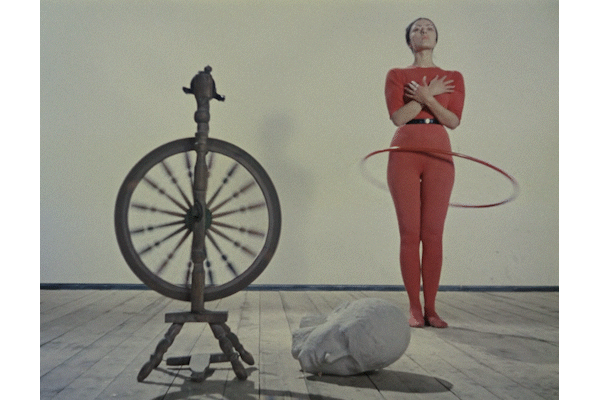
Geloopter Ausschnitt aus Sergej Paradjanovs "Kiev Frescoes"
© Alexander Dovzhenko National Film Studio, Loop: Jacob Franke
Although the project was called to a halt, the takes for Kiev Frescoes were still edited together, with a sound track. However, it is hard to say which images were really intended to be put together and which would only have remained at the rehearsal stage if they had been made into a whole film. Despite, or perhaps even because of this, the images we do see are compelling in a manner particular to Parajanov. In this respect, there is no significant difference between Frescoes and Parajanov’s completed projects, the scenes and shots of which, rather than primarily being connected through spatio-temporal cause and effect, tend to unfold by free association, the main interest being in their form. The topics of Frescoes, too, address many aspects found three years later in the film-maker’s masterwork The Color of Pomegranates (original title: Sayat Nova, USSR, 1969): The symmetry of frontal-view groups of three protagonists. Full shots of prone figures laid out in a strictly horizontal line from one side of the screen to the other and somehow appearing both dead and alive. Water washing across the pictorial space with no discernible source. Folkloric crafts. Many frames and windows – used in cinema to mirror the limiting and liberating nature of the screen’s edges since André Bazin3 introduced the concept, at the latest. The relentless, rhythmic ticking on the sound track. Open books scattered across the screen space. The stony, ethereal way the figures gaze into the camera.
3 Bazin, André [1975]: "What is Cinema?", Oakland: 2005.
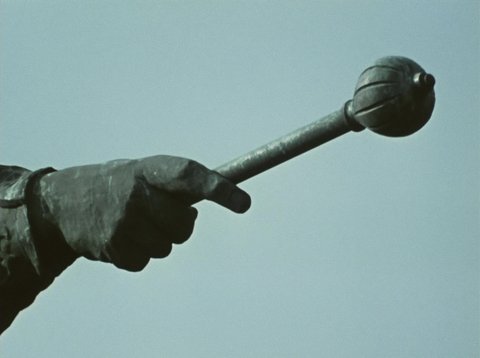
Filmstill aus Sergei Paradschanows "Kiewer Fresken" (1966)
© Alexander Dovzhenko National Film Studio
Kiev Frescoes was dedicated to the Wehrmacht’s attack on Kyiv in the Second World War. With no sign of Nazis or attacks, however, that background could easily be overlooked. Sometimes, it is precisely the things a film does not show that tell us the story. The background in question is largely flagged up by the opening shot, superimposing the obelisk on the eternal flame at the Tomb of the Unknown Soldier in Kyiv. The monument is the city’s way of commemorating the Nazi attack and the fallen Soviet soldiers. This shot is followed by a number of details and close-ups of distinctive landmarks in Kyiv, such as one of the many gold onion domes on the city’s cathedrals, and statues of Kyiv’s historical heroes including Vladimir the Great or the Cossack leader Bohdan Khmelnytsky, recognised by the bulava4 in his hand. In the 17th century, Khmelnytsky led the uprising against the Polish–Lithuanian Commonwealth that eventually resulted in Ukraine’s incorporation into the Tsardom of Russia. Vladimir, meanwhile, was the central figure in the Christianisation of Kievan Rus’ and thus pivotal to the significant role that the city – now almost thirteen hundred years old – plays as a key religious centre for the Russian and Ukrainian Orthodox Churches. In principle, the entire East European orthodoxy traces back to the marriage he engineered with the Byzantine princess Anna after his conquest of Byzantium in the year 988.
4 The bulava (a mace) was an emblem used by Zaporozhian Cossack military commanders and is now an important symbol of the President of Ukraine’s sovereignty.
In filmic terms, it is unusual at the very least to depict a city using these detail shots and outlines of landmarks. It is never seen as a city; never comes together to form a social and architectural whole. The same is true of all other shots, which – apart from the opening and closing sequences – all play out in a space that goes through scene changes as on a stage. Entering that space, we first come up against three Red Army soldiers, echoed in number and position by three portraits of nobles in the background and three wooden chairs in the foreground. This arrangement is shown in a frontal long shot that immediately gives the action its stage-like appearance, with a flatness almost like a painting. The symmetry of the arrangement and the trio repeated in the portraits and chairs underline that impression. Nothing about it seems random. Everything is artificial, choreographed and removed from reality, like the entire film. To this day, Parajanov is highly praised for his unique cinematic style. Martin Scorsese, for instance, described Parajanov’s work as “pretty much unlike anything in cinema history”.5 And the specialness of Parajanov’s film-making becomes even more obvious if its historical setting is taken into account. Just a few years before Kiev Frescoes was filmed, the French nouvelle vague sparked a cinematic revolution essentially designed to expose the artificiality of film universes by revolting against contemporary standards of cinematic storytelling using jump cuts, camera angles and other rule-breaking techniques. The French film-makers raised this rude awakening from such cinematic dream worlds to the status of a stylistic device, used to draw attention to the artificial nature of their creations. In Parajanov’s films, however, everything appears so extremely dreamlike and unnatural that no-one could fail to notice the artificiality of the images or the author’s hand. It comes as no surprise that Jean-Luc Godard, the intellectual among the French film revolutionaries, described him as a high priest of the temple of cinema.6
5 Scorsese, Martin (2014) as cited in Sloane, Peter: Kinetic Iconography: Wes Anderson, Sergei Parajanov, and the Illusion of Motion, in Texas Studies in Literature and Language, Vol. 60, No. 2, 2018, 246–268, 251.. [jstor]
6 Godard, Jean-Luc in Parajanov: The Last Collage (Ruben Gevorgyants, 1995) [link]
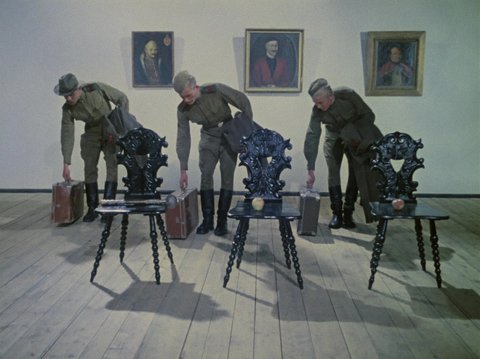
Filmstill aus Sergei Paradschanows "Kiewer Fresken" (1966)
© Alexander Dovzhenko National Film Studio
The only thing that does not appear unreal and artificial about the whole scene with the soldiers is when they laugh at aristocratic airs and graces, as represented by the portraits of nobles in the background. It is an excellent example of Parajanov’s associative play with form. On their chairs, two of the soldiers find an apple which they delightedly pick up. The third gets a bulava (the sceptre surmounted by a characteristic monde) and uses that for its natural purpose, gesturing regally. They laugh together. Sitting, the three of them take off their boots and the footwraps typically used by Russian armies and Ukrainian soldiers until the end of the 20th century. They put their empty boots on the chairs. The battle is over.
7 These are portraits of landed Polish-Lithuanian gentry: One can be identified as Petro Wojciechowicz, the second one assumedly is Ivan Skoropadsky, the third one couldn't be identified by the author.
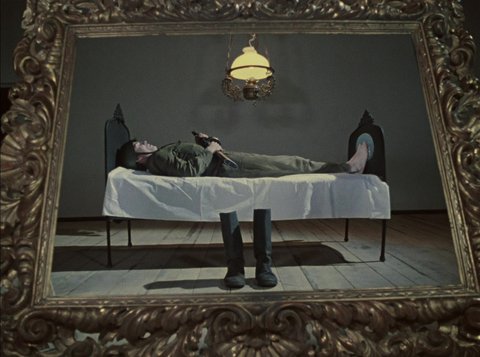
Filmstill aus Sergei Paradschanows "Kiewer Fresken" (1966)
© Alexander Dovzhenko National Film Studio
Following this, empty pairs of shoes become a recurring motif, standing for instance by the bed where a soldier lies, or on a sewing machine treadle. However, they no longer act as a symbol of battles that have come to an end: they are an aesthetic device creating a sense of oppression. The soldier, in full uniform apart from his shoes, lies in bed with a machine gun and helmet, in a shot frequently found in Parajanov’s work: a horizontal full-figure shot extending from one edge of the screen to the other. He groans and breathes in a dramatic manner that suggests he is on the verge of death. The posture of the two figures draped pathetically over a table beside him, and the ecclesiastical tones of the singing on the sound track, anticipate his passing and the ceremonial mourning that will accompany it. The empty shoes thus become reminiscent of the life that once filled them. They point to something that has been lost, seen only, through the shoes, as something missing. The same is true of the sewing machine treadle, on which two white, also empty women’s shoes are placed. Its slow, but constant rocking can be interpreted as the mechanical echo of a long-gone driving force – as if the machine has simply not yet noticed that it is no longer being driven. The shoes are, after all, still there. By this means, the sterility and heaviness meet with a playful resistance that makes no logical sense at all, but counters them with aesthetic defiance.
If we interpret the film against the background of the Nazi attack, these motifs can be understood as symptoms of trauma: the empty shoes, the prostrate soldier’s groans, the expressionless faces with thousand-yard stares – everything after the shot with the three soldiers implies that something terrible has previously occurred. The baroque frame surrounding the soldier’s prone figure in one shot accordingly no longer comes across as a Bazinian reflection on cinematics as a medium; instead, it is seen as an absolute means of presenting a collective wound, symbolising the inability to stop concentrating on the traumatic event. Karla Oeler, who wrote about Parajanov’s The Color of Pomegranates, thus places his works between those of James Joyce and Sergej Eisenstein – two absolute giants of modern storytelling – as his works express a collective consciousness (Eisenstein) as a free-flowing inner monologue (Joyce).8 Trauma is usually a psychological problem affecting an individual. In the case of war, however, that problem becomes a collective one and thus falls precisely into this intermediate position. What makes Parajanov’s film special is that it not only paints a fitting picture of the trauma shared by the masses, but also integrates it into a stream of subjective associations that make an appropriate setting in which to present it. As a result, it feels rather like we are dreaming a collective dream. That could equally be a definition of cinema. Perhaps Parajanov really is a high priest of film-making.
8 Oeler, Karla: A Collective Inner Monologue: Sergei Parajanov and Eisenstein’s Joyce-Inspired Vision of Cinema, in: The Modern Language Review, Apr., 2006, Vol. 101, No. 2, 472-487 [Link]
The gold frame appears again later, swinging back and forth like a pendulum in the screen space. A boy stands behind it on the lid of a black grand piano, which we also already recognise from previous shots. He throws paper aeroplanes through the frame. With his naive play, the boy symbolises how this dangling burden could be overcome. His planes’ path crosses that of the pendulum. He did not experience the battle for the city. It is in the nature of play that the rules of real life are briefly suspended; that things can take on another meaning, other priorities apply, square pegs fit in round holes or planes have to be thrown through frames. Play heals us from the constraints of reality. That is something it has in common with art.
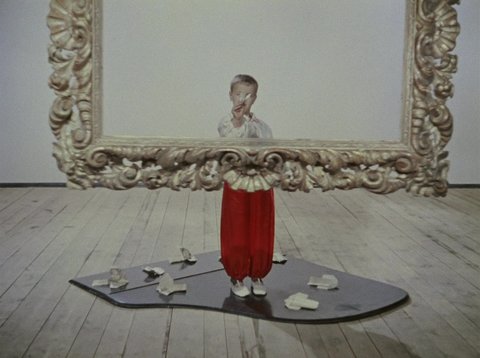
Filmstill aus Sergei Paradschanows "Kiewer Fresken" (1966)
© Alexander Dovzhenko National Film Studio
Parajanov did not experience the battle for the city. His relationship to the elements in the shots is also playful: in terms of form they often match, mirror and rhyme with one another. Many elements such as the empty shoes, the bulava and the frame reappear in other images, changing meaning, subverting expectations and taking on symbolic dimensions. The black grand piano, for example, is seen in several shots in which the space is always different, but still recognisably the same.9 In these shots we see a man on the right and a woman on the left. In the background, on the left, a white wedding dress hangs on a coat rack in front of a black tailcoat, superimposed against it to suggest a visual analogon with the black sleeves of the woman’s clothing. As the woman walks past the arrangement composed of these two items of clothing, she twirls, evoking an intimate lovers’ dance. One shot later, the man happily presents us with a ring. But the joy does not last long.
9 The objects, figures and their composition constantly change, but the shots are similar. The only things that stay the same are the floorboards and the white wall in the background. Sometimes there is a window, sometimes a wall, sometimes a wooden frame. Then a carriage suddenly appears or a pram rolls into view. The space is more reminiscent of a theatre stage than of a filmic space.
The woman in the white dress and black sleeves pulls the ring off her finger and holds it up for us to see, gazing at us with a lost expression. As with the empty shoes, we interpret that as a sign of loss. Shortly after, that reading gains further weight when the man abruptly hurls his own ring into the strings of the lidless grand piano, making one of the relatively scarce intradiegetic10 sounds we hear. He then lies on his back on the piano with his arms crossed like a pharaoh. By this point at the latest, in retrospect, the discordant clanging elicited from the piano strings through the force of his action can now be understood as a metaphorical gunshot. This brutally cuts across the otherwise so carefully controlled arrangement, in clear contrast to the distinctly sedate theatricality of the other events so far in this scene, which have been accompanied by pleasantly tinkling music. The sound clangs out again at the end of the scene. This acoustic shock is later reprised as a recurring motif that cuts brutally through the action in contradiction to the element of play. Play requires a distance to be maintained from reality. The film revolves around the possibility and impossibility of overcoming the obstacles to achieve that distance. That is something that comes easily to the child.
10 Sound that is part of and belongs to the world in the story, in contrast to film music, which in most cases is heard only by us as the audience.
However, the narrative part of the film ends not in play, but in that same ghastly clanging. Leading up to that are a series of escalating acoustic events, from Mussorgsky’s Pictures at an Exhibition to the penetrating ringing of a handbell and the discordant twanging of an untuned lute: sounds that become increasingly, wearingly obtrusive. A man lying on a couch writhes convulsively in his sleep. After a woman in a surgical mask appears to give him an injection, he awakes. We have seen the woman shortly before, twirling a hula hoop with her hips. At that point, we did not know she was a healthcare worker. Perhaps it was part of the man’s feverish dream, from which he then awakens to find himself in another new yet familiar room. The sound track plays Anastasia by Pat Boone: “Anastasia, smile away the past. Anastasia, spring is here at last...”. Opposite the man is a naked woman, and on the floor lie sawn-off sections from the trunk of a birch tree. The birch is an important tree in Slavic folklore, symbolising spring and thus renewal. An axe is embedded in one of the chunks. The man grasps the axe with the half-chopped section of tree trunk still attached to it, and makes as if to split it. The naked woman is still standing a short distance away, in the direction he swings.
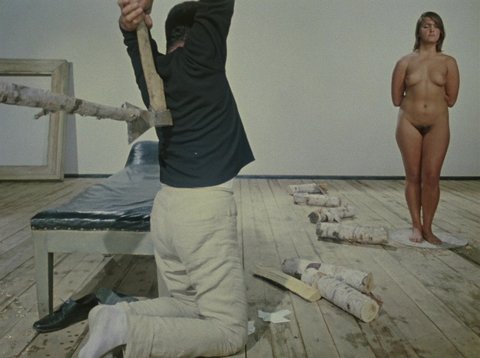
Filmstill aus Sergei Paradschanows "Kiewer Fresken" (1966)
© Alexander Dovzhenko National Film Studio
As the image abruptly fades to black, we hear the piano gunshot clash out one last time. Finally, we again see detail shots of Kyiv, bookending the film along with the opening shots. Once again, we see the things in the city at such close range that they can never be made out in their entirety. There are no postcard views of Kyiv. The city only becomes known to us as a concept; as the whole of the fragments we are shown. As such, Kyiv resembles the birch sections, the images and the scenes. It resembles the film as a whole and, undeniably, what is written about the film. And finally, it resembles history, especially that of war.
[Translated from German by Schweitzer Sprachendienst]
Also of interest:
Kavaleridze's "Prometheus": Ukrainians, frogs, and Socialist Realist cinema
Ivan Kavaleridze has played a significant role in Ukrainian culture. His name, however, is little known in contemporary Ukraine, and few people have heard about him outside the country. Currently, excerpts from his film "Prometheus" can be seen here on voices and in the Albertinum, the model for one of his sculptures is on display in the exhibition "Kaleidoscope of Historie(s)". Stanislav Menzelevskyi on Kawaleridze as a filmmaker and the banning of his movie Prometheus.
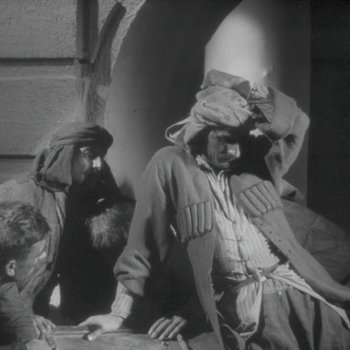
What coins and medals say about epidemics
What we can learn from coins and medals goes far beyond discovering hidden hoards or studying the economic consequences of events. Such artefacts also tell us about societies’ beliefs, hopes and fears. Currently, an exhibition at the Münzkabinett (Numismatic Collection) is devoted to the connection between coins and epidemics. Curator Ilka Hagen explains here what one has to do with the other.
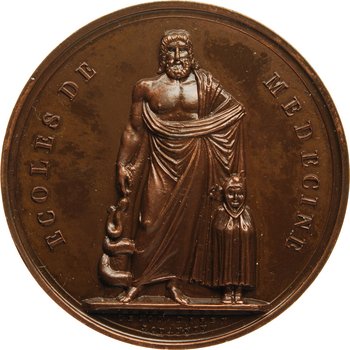
The Children of Marx in the Land of Hồ Chí Minh: Quang Trung housing complex in Vinh City, Vietnam
The annihilation of Vinh City by US bomb raids offered an opportunity for experimental planning and for transforming the small industrial town into a model socialist city. The GDR’s ambitious task of comprehensive reconstruction involved working collectively on both the creation of a master plan and its realization in built form. Christina Schwenkel on the Quang Trung housing complex.
